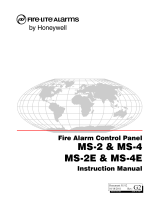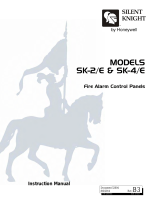Page is loading ...

Installation Sheet 18AUG05 P/N: 3100687 REV: 2.0
SuperDuct Four-Wire Controller (RJ-45 version) 1 / 4
SuperDuct
Four-Wire Controller (RJ-45 version)
Product description
The SuperDuct four-wire controller coupled with a compatible sensor
make up a SuperDuct four-wire duct smoke detector. The sensor
sends an alarm signal to the controller when smoke is detected in the
HVAC system. Upon receipt of the alarm signal, the controller takes
the appropriate actions to provide early warning of the impending fire
and prevent smoke from circulating throughout the building. The
controller can be configured for a range of operating voltages and
supports one or two compatible sensors.
WARNING: SuperDuct duct smoke detectors are not intended as a
substitute for open area protection.
The controller comprises a plastic housing, a printed circuit board, and
a clear plastic cover. The clear plastic cover is secured to the housing
with a single captive screw for easy access to the wiring terminals.
Knockouts are provided to route wires into the controller housing.
The controller contains no user serviceable parts.
This document provides installation instructions for the following
SuperDuct four-wire controllers:
Model Description
TSD-CJ, ESD-CJ, SD-CJ
Four-wire controller with RJ-45 modular
connectors
TSD-CJG
Four-wire controller with RJ-45
modular connectors and cover gasket
TSD-4WJ, ESD-4WJ,
SD-4WJ
Combination four-wire controller and
sensor with RJ-45 modular connectors
This product will not operate without at least one compatible sensor.
The table below lists the compatible four-wire smoke sensors that you
can use with the controllers listed above.
Controller Compatible sensor
TSD-CJ, TSD-CJG, TSD-4WJ TSD-SJ, TSD-SJG, TSD-SJCO2
ESD-CJ, ESD-4WJ ESD-SJ
SD-CJ, SD-4WJ SD-SJ
Note: The TSD-CO2 module has not been performance evaluated to
UL 2075 or approved by ULC.
Related documents
In addition to this document, information about sensor installation and
duct smoke detector testing and maintenance can be found in the
following:
• SuperDuct Four-Wire Smoke Sensor (RJ-45 version) Installation
Sheet (P/N 3100686)
• SuperDuct Four-Wire Duct Smoke Detector Technical Bulletin
(P/N 3100685)
Specifications
Dimensions
Controller: 6.75 x 5.45 x 1.90 inches
Controller with detector: 14.51 x 5.45 x 1.90 inches
Wire size
High voltage terminals: 12 to 22 AWG
All others: 14 to 22 AWG
LED indicators: Alarm (red), Trouble (yellow), Power (green)
Alarm initiation relay
Quantity: 1
Style: Normally open
Ratings: 2.0 A at 30 Vdc (resistive)
Auxiliary relay
Quantity: 2
Style: Form C
Ratings: 10 A at 30 Vdc, 10 A at 250 Vac (contacts must switch a
minimum of 100 mA at 5 Vdc)
Supervision (trouble) relay
Quantity: 1
Style: Form C
Ratings: 2.0 A at 30 Vdc (resistive)
Auxiliary output: 18 Vdc, nom., 30 mA, max.
TSD-CO2 module output: 0 to 10 Vdc (0 to 2,000 ppm)
Operating environment
Temperature: -20 to 70 °C (-4 to 158 °F)
Temperature with TSD-CO2 module installed: 0 to 55 °C (32 to
131 °F)
Humidity: 10 to 93%, RH noncondensing at 68 to 72 °C (154.4 to
161.6°F)
Operating voltages: 20 to 29 Vdc (-15 to 10%), 24V (-15 to 10%) at
50/60 Hz, 120V (-15 to 10%) at 50/60 Hz, 220/240V (-15 to 10%)
at 50/60 Hz
Operating currents: See table below
Supply voltage Standby current Alarm current
24 Vdc 77.9 mA 124.3 mA
24 V at 50 Hz 215.3 mA 307.0 mA
24 V at 60 Hz 220.0 mA 316.5 mA
120 V at 50 Hz 91.0 mA 89.0 mA
120 V at 60 Hz 79.0 mA 74.0 mA
220/240 V at 50 Hz 44.9 mA 44.0 mA
220/240 V at 60 Hz 34.5 mA 32.0 mA
Note: The TSD-CO2 module has not been performance evaluated to
UL 2075 or approved by ULC.
Installation guidelines
Install in accordance with all applicable national and local codes as
determined by the local authority having jurisdiction.
Do not install a controller more than 15 feet away from a sensor.

P/N: 3100687 REV: 2.0 18AUG05 Installation Sheet
2 / 4 SuperDuct Four-Wire Controller (RJ-45 version)
Run all field wiring through the knockouts located on the bottom of the
controller housing. Maintain a 1/4-inch separation between power-
limited and nonpower-limited wiring at all times.
Installation instructions
Please read these instructions thoroughly before installing. In addition
to this document, important information can be found in Technical
Bulletin P/N 3100685.
Step 1: Mount the controller
Mount the controller on a flat section of HVAC duct or sheet metal as
shown in Figure 1 using the sheet metal screws provided in the
hardware kit. The controller does not have to be mounted next to the
sensor.
HVAC duct
#10 sheet metal screw
(3X)
Controller
Figure 1: Controller mounting diagram
If you are installing a controller combined with a sensor, mount both on
a flat section of HVAC duct as shown in Figure 2.
Airflow
Sampling
tube
#10 sheet metal screw
(2X)
Sensor
Controller
Exhaust
tube
HVAC duct
Figure 2: Mounting a controller combined with a sensor
Step 2: Attach the conduit support plate
Open the controller and remove the terminal block cover. Attach the
conduit support plate as shown in Figure 3.
Conduit coupling
(supplied by installer)
Coupling nut
(supplied by installer)
Conduit
support
plate
Figure 3: Conduit support plate installation
Jumper configuration
Set the controller configuration jumpers as described below.
Note: Failure to remove JP1 prevents the controller from indicating a
trouble condition with the sensor connected to J2. It does not prevent
the controller from responding to an alarm signal.
JP1
JP2 & JP3
Figure 4: Controller jumper locations
JP1 jumper settings
Position Description
IN
Controller connected to one sensor (factory
setting)
OUT Controller connected to two sensors
JP2, JP3 jumper settings
Position Description
JP2 JP3
Controller connected to 24 Vdc, 24 Vac, or
120 Vac (factory setting)
JP2 JP3
Controller connected to 220/240 Vac

Installation Sheet 18AUG05 P/N: 3100687 REV: 2.0
SuperDuct Four-Wire Controller (RJ-45 version) 3 / 4
Controller to sensor wiring
Connect the controller to the sensor as shown in Figure 5. Make sure
the cable grommets are seated securely into their respective openings.
First sensor
Controller
Optional second sensor
RJ-45 cable assembly
(ordered separately)
RJ-45 cable assembly
(ordered separately)
J1
J1
J1
J2
Figure 5: Controller to sensor wiring diagram
RJ-45 cable assemblies are available in the lengths listed below.
Model Description
SD-RJ5 RJ-45 wiring harness kit (5 ft)
SD-RJ10 RJ-45 wiring harness kit (10 ft)
SD-RJ15 RJ-45 wiring harness kit (15 ft)
Notes
• If strain relief is required, secure the cable using the cable clamps
provided with the cable kit
• If you are connecting the controller to two sensors, remove JP1
Field wiring
Bring all field wiring into the controller through the knockouts on the
bottom of the housing as shown in Figure 6. Keep all power-limited
wiring in the shaded area and all nonpower-limited wiring in the area
that is not shaded.
Remove the terminal block cover and connect the field wiring as shown
in Figure 8. Replace the terminal block cover when finished.
Note: Maintain a 1/4-inch separation between power-limited and
nonpower-limited wiring at all times.
Power-limited
Nonpower-limited
Figure 6: Power-limited and nonpower-limited wiring areas
Figure 7 shows the terminal block cover that is installed on the
controller. The markings identify the function and number of the screw
terminals found underneath.
1
20
10
19
9
18
8
17
7
16
6
15
5
14
4
13
3
12
2
11
COM
ALARM
REM
LED
OUT
(+)
USED
NOT
MULTI-
SHUT-
DOWN
SUPV.
CONTACT
AUX
CONTACT
OUTPUT
18Vdc
N.O. N.C.
(-) (+)
N.C. N.O. COM COMN.O.
N.C. N.O.
COM
AUX
CONTACT
24VAC
20-29Vdc
or
ALARM
CONTACT
RESET AUX
(-)
120VAC
* FOR 230VAC,
NL
CAUTION: HIGH VOLTAGE
120V 120V
230V *
REF. INSTALL SHEET
31006873100730
(-) (+)
Figure 7: Terminal block cover
Testing
After completing the installation, test the controller to ensure that it is
operating correctly before leaving the site. For details, refer to
Technical Bulletin P/N 3100685.

P/N: 3100687 REV: 2.0 18AUG05 Installation Sheet
4 / 4 SuperDuct Four-Wire Controller (RJ-45 version)
10
9
J1
J2
RJ-45 cable [9]
RJ-45 cable [9]
1st sensor
2nd sensor [1]
J1
J1
L
N
L
N
17
7
6
18
16
8
Auxiliary
equipment
Auxiliary
equipment
Controller A
5
4
Alarm initiation
contacts [2]
5
4
Alarm initiation
contacts [2]
10
9
J1
J2
17
7
6
18
16
8
Controller B
Supervision relay
(supplied by installer)
[11]
EOLR [4]
(supplied by
installer)
RJ-45 cable [9]
RJ-45 cable [9]
1st sensor
2nd sensor [1]
J1
J1
JP1
JP2 JP3
120V
230V
JP2 JP3
120 V
230V
JP1
+
−
+
−
Auxiliary
equipment
Auxiliary
equipment
+
−
Initiating device circuit
on fire alarm
control panel [7]
120V/220V/240V [5]
24V AC/DC24V AC/DC
120V/220V/240V [5]
1
12
2
1
1
12
Multiple fan shutdown [8]
TB3
Auxiliary
equipment
2
1
TB3
TSD-CO2 module
output [10]
TSD-CO2 module
output [10]
+
−
Auxiliary
equipment
+
−
14
13
19
15
2
20
3
Reset/Test
Trouble
Power
Alarm
SD-TRK4 or SD-TRM4 [6]
Supervision relay
contacts [3]
5
4
1
3
2
14
13
19
15
2
20
3
Alarm
Supervision relay
contacts [3]
1
2
5956A
18 Vdc ( )
+
18 Vdc ( )
−
18 Vdc ( )
−
Wire must be
added by installer
CAUTION
Do not use looped wires under
terminals 5 and 4. Break wire runs
to provide supervision of connections.
CAUTION
Do not use looped wires under
terminals 5 and 4. Break wire runs
to provide supervision of connections.
Notes
[1] Remove JP1 when the controller is connected to two
sensors
[2] Alarm initiation contacts shown in normal condition. Contacts
close on alarm.
[3] Supervision relay contacts shown in normal condition.
Contacts change over on sensor or controller trouble.
[4] Install end-of-line resistor on last controller only. EOLR value
determined by fire alarm control panel.
[5] Move JP3 to the 230V position only when using 220V or
240V to operate the controller
[6] No more than two remote test/reset stations can be
connected to the same controller. Wiring is nonsupervised.
Maximum wire resistance is 10 ohms per wire.
[7] Control panel provides supervision and determines wire
requirements
[8] Wiring is nonsupervised. Wire resistance from first controller
to last controller can not exceed 5 ohms.15 controllers, max.
[9] Wiring is supervised by the controller. Maximum wire
distance is 15 ft.
[10] TSD-C02 module has not been performance evaluated to
UL 2075 or approved by ULC
[11] Only required when using a remote test/reset station and
the controller is wired to a fire alarm control panel. Otherwise,
use the supervision relay contacts as shown on Controller B.
Figure 8: Controller wiring diagram
/




